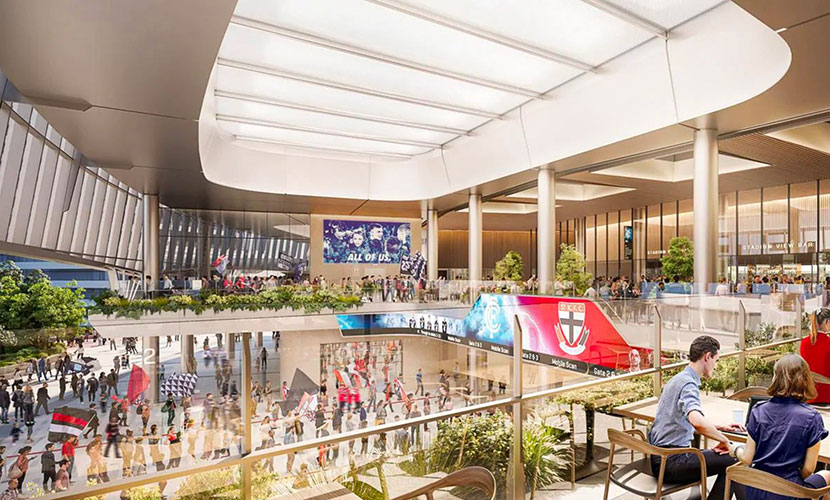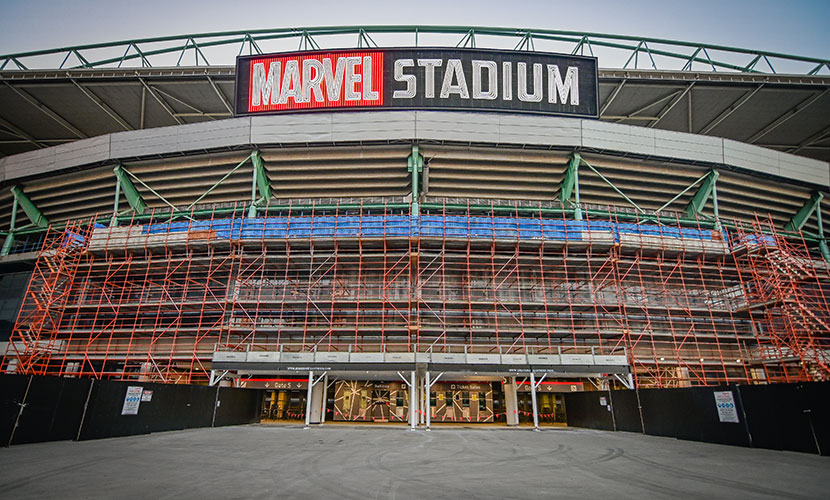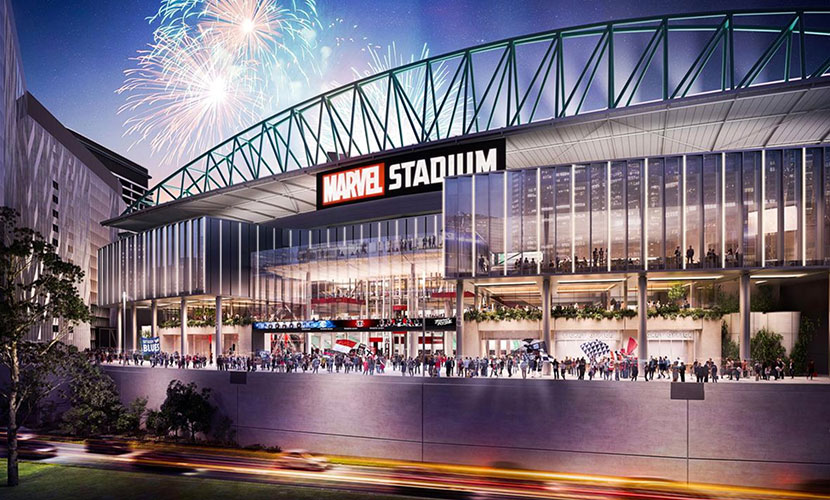“The success of the precinct and stadium are interlocked”: Local focus on Marvel revamp
Key figures involved in the Marvel Stadium redevelopment have told Docklanders that the long-term success of the AFL-owned arena depended on how it connected with the local community, pledging a renewed focus on non-event days.
Acknowledging that the stadium’s current “citadel”-like walls and dated concourse did not create an inviting environment, details were shared about how the redevelopment would contribute as a civic space.
Work on the project is already underway and is expected to be largely completed by late 2022.
A host of representatives including from the AFL, Grimshaw Architects, and builder John Holland Group addressed and took questions from locals in an online panel organised by the Docklands Representative Group (DRG) on November 24.
Each said the redevelopment would focus on the “everyday mode” of the stadium; specifically, the approximately 280 days per year it did not host an event.
“Yes, it’s really efficient and works really well on game day, but it also has an identity within its everyday mode, which is probably lacking at the moment,” Grimshaw principal Simon Anson told locals on the Zoom event.
“How can it contribute into that event and everyday mode into the local community?”
Mr Anson said the difference between when the stadium was built (at the turn of the century) and now was stark, and that the huge transition Docklands had undergone since needed to be reflected in the stadium.
“The stadium was built before the surrounding precinct, and in a lot of ways doesn’t open up to it … as the city has grown, you realise it’s actually a piece of the city fabric. No longer can you understand it as a whole unless you’re viewing it from the harbour. The way it interacts with the civic precinct around it is incredibly important to its future success.”
He said a key focus of design elements was about ensuring those walking past could see right through to the playing surface, “opening up the inside of the stadium to the outside, and vice versa”.
According to the firm, a Docklands focus was prominent from the outset.
“When we started this project, a lot of the questions we were asking ourselves was ‘how can it contribute to the precinct in a civic way? How can it give back to the precinct, and interact, and really start to be a catalyst for this regeneration of Docklands?’”
The stadium primarily operates as a sporting arena, for Australian rules football in the winter months, and cricket and soccer during the summer.
It also operates as an entertainment venue for concerts, and large functions.
Redevelopment plans were released in late 2020 and revealed a strong focus on the stadium’s southern side (or “Town Square”) and eastern “City Edge” along Wurundjeri Way.
Mr Anson told locals that the Town Square component in particular was where “the stadium embraces the precinct”.
This large concourse area — at the end of the pathway from Southern Cross Station — will see the stadium’s facade stripped back and “opened up”.
It was revealed that the stadium’s gate line would become flexible, and pushed back on non-event days, something he believed was a world-first.
Upon competition, the Town Square would represent a “day-lit, undercover civic space”, including food and beverage offerings, not dissimilar to the Collins Square redevelopment that Grimshaw also led.

Local input sought for concourse activities
The Marvel Stadium concourse has long been criticised as uninspiring and was referenced on the evening as a “desolate concrete area”.
Moves have been made to activate the area outside the arena once redevelopment works were complete, and preliminary ideas included a night market, pop-up park and cultural festivals.
Driving this was placemaking group Village Well, which pledged to push for grassroots ideas as part of this.
“Great places that are locally loved have some level of local participation,” managing director Gilbert Rochecouste said.
“I think we need to go through another process of engagement with the community to see potential fits and what will work for the area on game day and non-game day. The key word here is ownership and having some skin in the game, where we see some of these great institutions that have a local population have some say.”
He said that while big event days would take care of themselves, it was the “everyday mode” that would determine long-term success.
There’s going to be big events that land and we know that. But it’s those micro-events that bring the community along on the journey to have some say, but also some ownership which I think could be really powerful.
A heads-up on disruptions
Details also emerged about disruptions set to be caused by upcoming works, which will be felt most by those living in the Lacrosse building at the northern edge of the stadium concourse, and Victoria Point at the ground’s southern edge.
Works on the City Edge side of the stadium will take place between January and May.
For Town Square, hoarding will start going up in the New Year, with demolition works starting in early April and construction to be complete around August.
Below-the-surface works had already begun.
While there will be disruption on the city-side of the stadium concourse during construction (including the installation of a temporary vehicle ramp along Wurundjeri Way), public access around the stadium concourse would be “maintained at all times” according to John Holland Group.
Services manager Oliver Crowther said works would not adversely impact upcoming events.
“One of the largest factors for us as a construction team was really to ensure the stadium stayed operational,” he said.
“One, for the patrons that live in the community. And also for those attending the stadium for events. We’ve maintained complete access all of the way around the stadium, and complete access into the stadium for events.”
Much of the stadium’s structure will remain in place during the works which, according to John Holland, was “good news for local residents” from a noise perspective.
What about Harbour Esplanade?
Since the release of redevelopment plans, there had been disappointment from some quarters that the concourse revamp did not have a western or “harbourside” focus.
AFL project director Geoff Miller said the project had focused on the eastern and southern sides of the ground as they were the areas of highest patronage; particularly the south with patrons arriving from Southern Cross Station.
He did not rule out further upgrades to the Harbour Esplanade side of the stadium concourse in future.
“I think it’s fair to say that the AFL have further aspirations for further improvements to the stadium beyond this,” Mr Miller said.
Prior to COVID-19, the AFL had a multi-million-dollar deposit on a parcel of land on La Trobe St (on the stadium’s northwest corner) that it had earmarked for green space as part of the redevelopment.
But the league backed out of the deal when the pandemic struck and offloaded the site to shore up its financial position after suffering a significant hit to operations.
“The last few years have presented a lot of challenges for all of us, and the AFL are certainly in that camp,” Mr Miller said.
The $225 million Marvel Stadium upgrade is funded by the state government after the AFL, in a 2018 deal, committed to keeping the Grand Final within Victoria until at least 2058, quelling strong interest from rival states •

New park to revitalise historic maritime precinct in Docklands








 Download the Latest Edition
Download the Latest Edition